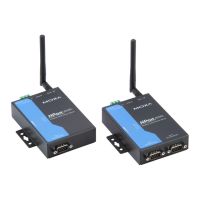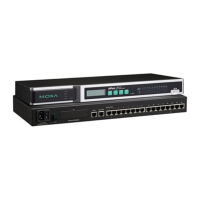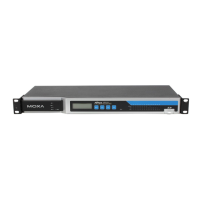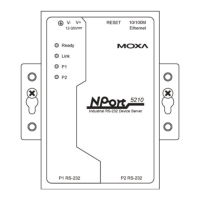NPort W2150/2250 Plus Series User’s Manual Introduction to Operation Modes
4-2
Overview
This chapter introduces the different serial port operation modes that are available on the NPort
W2150/2250 Plus Series. Each serial port on the NPort is configured independently of the other
ports, with its own serial communication parameters and operation mode. The serial port’s
operation mode determines how it interacts with the network, and different modes are available to
encompass a wide variety of applications and devices.
Real COM and RFC2217 modes allow serial-based software to access the NPort serial port as if it
were a local serial port on a PC. These modes are appropriate when your application relies on
Windows or Linux software that was originally designed for locally attached COM or TTY
devices. With these modes, you can access your devices from the network using your existing
COM/TTY-based software, without investing in additional software.
Three different socket modes are available for user-developed socket programs: TCP Server,
TCP Client, and UDP Server/Client. For TCP applications, the appropriate mode depends on
whether the connection will be hosted or initiated from the NPort serial port or from the network.
The main difference between the TCP and UDP protocols is that TCP guarantees delivery of data
by requiring the recipient to send an acknowledgement to the sender. UDP does not require this
type of verification, making it possible to offer speedier delivery. UDP also allows multicasting of
data to groups of IP addresses and would be suitable for streaming media or non-critical
messaging applications such as LED message boards.
Pair Connection Slave and Master modes are designed for serial-to-serial communication over
Ethernet, in order to overcome traditional limitations with serial transmission distance.
In Ethernet Modem mode, the NPort acts as an Ethernet modem, providing a network connection
to a host through the serial port.
Terminal ASCII and Binary modes are designed to connect serial-based terminals to a server on
the network.
Reverse Telnet mode is designed for connections to servers that will host terminal sessions
through the NPort serial port. This mode is typically used for console management applications,
but can also be used to upgrade legacy servers to network operation.
Real COM Mode
Real COM mode is designed to work with
NPort drivers that are installed on a
network host. COM drivers are provided
for Windows systems, and TTY drivers
are provided for Linux and UNIX systems.
The driver establishes a transparent
connection to the attached serial device by
mapping a local serial port to the NPort
serial port. Real COM mode supports up
to four simultaneous connections, so
multiple hosts can collect data from the
attached device at the same time.
Real COM Mode
Proceed directly with data
transmission (connection
request not required)
TCP/IP
WLAN
NPort W2250
Antenna
Port 1
RS-232/422/485
Port 2
RS-232/422-485
Wireless Serial Device Se
rver
W2250
Reset
Ethernet
12-48 VDC
Ready
WLAN
Serial 1
Serial 2
Serial Signal
Serial Device

